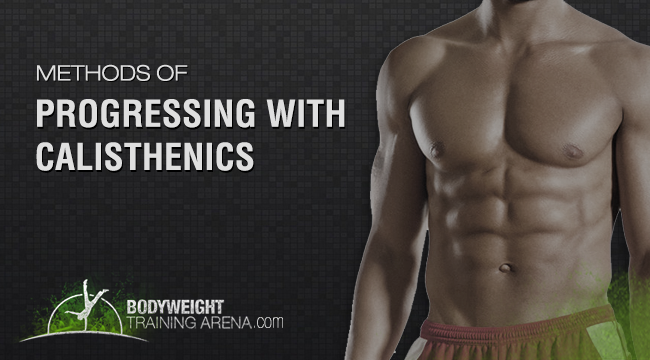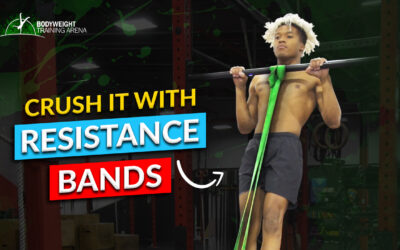Calisthenic Progressions are Your Secret Weapon
So as we said last time, progressive resistance is your secret weapon in your arsenal[/tweet_box], that ace in your sleeve, the ultimate thing that turns any ordinary human into extraordinary. Its simple, and incredibly effective. Remember if you are not progressing you are dying.
Just to remind you, what are progressive resistance or calisthenic progressions? Simply it is the principle of gradual increase of resistance.It states that you should do more with time, as well as you should move from the easiest task to the hardest. The most basic application of this principle is to add repetitions.
However, adding reps is not the only way to progress. You can add sets, decrease the time between sets, increase the working weight or move to harder exercises. In a nutshell, you need to be improving otherwise there’s no point in doing the same thing at the same pace over and again. It doesn’t really matter what you are using as a resistance; barbell, dumbbell, bodyweight, sandbag all are the same. Make it progressive and work up to hardest exercises.
So below is a number of ways to increase progressive resistance:
Methods of progressing in calisthenics
1. Add repetitions, sets, increase time between sets.
So these are really your basic ways to progress as in any training. Depending on your goal you will want to keep a particular sets/ rest times and repetition. So if you are just starting out I wouldn’t mess around with those and just stick with what is recommended. You will see also that depending on where you are with your progressions you will be using the variety of progression methods. Eg. when you start off with wall pushups, you really want to be able to do 3 sets of 30 before you progress (according to Convict Conditioning). So first you will be starving to improve the number of reps, then adding some sets, and then eventually moving to the more difficult exercise. Just a quick note that as you will learn later the number of reps is not definite, and different schools of thought might ask you to do different number. Point being, if you feel comfortable enough with one level, you should start slowly moving to the next one. As you will become more knowledgeable you will be able to know exactly when to move. But for those who are just starting out we will give a very clear guidance.
2. Increase range of motion:
It is one very effective method in progression. In this method, if you’re unable to do a particular exercise to its full range of motion then it is suggested to decrease its range of motion and then slowly and gradually build up to its full range of motion. Here, let me make it a little more clear to you. Let’s take the example of Handstand push-ups; if you can’t do a full handstand push-up then you can decrease its range of motion by stacking some books under your head. And then when you start to get stronger, you can increase the range of motion by removing the books one after the other. Also by using this method you can increase the difficulty and range of motion of exercise as well. Just give it a thought. Wouldn’t it make the exercise tougher if you had books under your hands? Yes, you guessed it right. This method works well with pushing exercises but is pretty hard to be normally applied to pulling exercises.
3. Add weight:
This is another very legitimate and effective way to progress from one progression step to the other. In this method you add some additional weight along with your bodyweight and then perform the exercise. Take for example; if you are doing planks and the exercise has gotten very easy for you, then you can always increase the difficulty of the exercise by putting some weight on your back and then performing it.
4. Change position of body in space:
In this method you change the position of your body to make the exercise easier for you and then perform it. Slowly when you gain strength you move towards making the exercise more difficult and eventually to its regular form. For example- If you can’t do a regular push-up, then try doing it against a wall and build up your strength, then move to an elevated surface. Once you start finding the exercise easy for you, move to a more difficult position and down the line you’ll find yourself performing regular push-ups with ease.
5. Combine difficult and easy exercises:
In this method you combine an easy exercise with a difficult exercise and then perform them together. Like, performing planche push-ups. First you take a planche position then you do a push-up without landing your feet on the ground and repeat this for a desired number of times. This method is amazing. Let me tell you this that I have tried this myself and have seen results for me. I am a live witness that this method is effective and if you do this then results are guaranteed.
6. Combining exercises into more complex moves:
Adding weight or increasing range of motion is not the only methods in your arsenal. Try combining exercises. For example, if you became proficient in Muscle-Ups and Front Levers, you can combine them into Muscle-Up to Front Lever sequence and perform them like one exercise. Here’s the freedom. No boundaries.
7. Bend the rules and have fun
After all this there comes one thing in the mind that do you have to follow these rules very strictly? And please let me tell you NO. Bending the rules have always been fun and what good is it to do something if you’re not having fun with it. For now I would suggest to stay with those rules, of calisthenic progressions, but as you learn more and go along you will be able to apply your own learnings to create new ways to increase resistance.




Here are so many valuable advices! I am thinking of printing this page not to forget something. I have some experience in calisthenic progressions. It is really important to go further because there is no sense in doing the same exercises every time. Although you wrote this are the basics, I even think it’s more than just the basics and very detailed. I like your advice to make it fun because we’ll enjoy much more.
What time is necessary to see the real results and change in our body?
very informative article I have to say. I do have one question about reps and sets: When I used to get taught gym exercises I would be told to do 3 sets of 15. does your body need it to be that repetitive, or could I do 3 sets of as many as I can do each time, for example 25 reps then 21 reps and then 18 reps for the final set? I feel like this would give a stronger workout and push me to my limits more . not sure if this is not recommended to do or not though? would love to hear what you have to say about it. Thanks
Interesting article.
I should add that these methods won’t necessarily increase your muscle mass. They will add some of course, but as you get more advanced in calisthenics, the excersises become more and more taxing on the nervous system, to an extent that your nervous system will be exhausted before your muscles will.
This will result in a very strong nervous system, but not nessecarily a very muscular physique. A good example is Bruce Lee: He can do a two-thumb planche – which is absolutely incredible, but would considered thin in the bodybuilding world.
I figured this is what was meant by progressions. Thanks for the clear explanation, it is one that will certainly help the beginners out there!
Dude!!! This is SO informative. I’m still on number 1 and 2 though. Will move on to the other points soon.
I just wanted to say that this was an amazing article. People spend a ton of time and energy looking for these answers. Thank you!